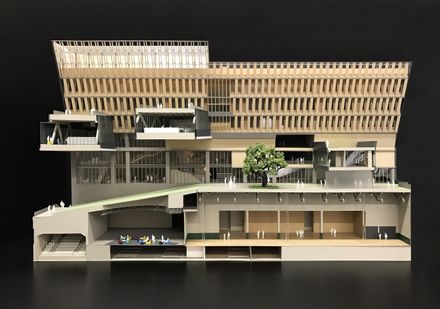
Chu Hai College Campus
ARCHITECT
Rocco Design Architects Limited
PHOTOGRAPHS
Virgile Simon Bertrand
CATEGORY
Higher Education
LOCATION
80 Castle Peak Road, Castle Peak Bay, Tuen Mun, N.T., Hong Kong
LEAD ARCHITECT
Rocco Yim
CLIENT
Chu Hai College of Higher Education
MAIN CONTRACTOR
CR Construction Company Limited
QUANTITY SURVEYOR
Rider Levett Bucknall
ACOUSTIC
Shen Milsom & Wilke
BUILDING SERVICES
J. Roger Preston Limited
CIVIL
Ove Arup & Partners
GEOTECHNICAL ENGINEERING
Ove Arup & Partners
ENVIRONMENTAL
Ove Arup & Partners
TRAFFIC
Ove Arup & Partners
PROJECT MANAGER
Ove Arup & Partners
STRUCTURAL
Ove Arup & Partners
AREA
26500.0 m2
MANUFACTURERS
AkzoNobel, Guang Ya Aluminium Industries, Redland Concrete
BEAM ACCREDITATION
Allied Environmental Consultants Ltd.
YEAR
2016
LANDSCAPE
Earthasia Ltd.
PROJECT TEAM
Rocco Yim, CM Chan, William Tam, Henry Ho, Stephen Chan, Hoi-Wai Sze, William Lee, Li Qingyue, Agnus Lau, Alan Chiang, Nicholas Ho
Text description provided by architect.
The new campus design signifies a highly linked & connected institution. It looks into the compact urban condition of Hong Kong itself for direct inspiration and epitomizes a miniature city, dense and connected.
The spatial organization maximizes density by stacking multiple slab blocks of different programs vertically on top of each other over a podium of communal activities, including a number of lecture theatres and a gymnasium.
A folded vertical Student Boulevard rises to form a 3-dimensional street network in the air that weaves and binds the different blocks and levels into a connected whole.
From the Boulevard, students can gain free access to a series of sky gardens and roof decks of various scales on different levels: turfed green lawn sloping towards the sea, student plaza & mini café etc., all afforded with magnificent sea views and lively atmosphere.
The footprints of the buildings are restricted to that of the existing foundations to minimize unnecessary modification.
Programs requiring larger footprints such as the classrooms and libraries are suspended out from the main slab blocks to make up for the required floor area.
Architecturally, the library and the student union are remodeled as bridges that connect the east and west slab blocks into an iconic gateway.
The classrooms on the upper floors are tapered outwards, creating a sloping wall as a reflector to redirect sunlight to the interior corridor and allow natural ventilation to reach the lower levels.
The elevation of the building reflects an authentic expression of its complex section. Formally, the cantilevers and bridges extending from the slab blocks resemble the image of a tree crown and symbolize the primitive learning space under the shade of the green canopy.
Its composition and construction also resemble the inherent spirit of Chinese Calligraphy, namely the beautiful balance of solid and void in the elevation.
The erection of the new campus in essence alludes to the creation of a new character: a new rudiment that would form the root of new knowledge for the generations to come.























